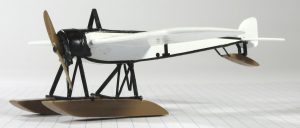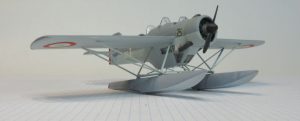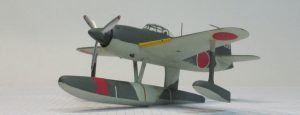Floatplanes
Morane H hydroplane, Liore et Olivier H.43, Kawanishi N1K1 (Rex)
I was browsing in the Gallery of the 1910s the other day when the little Morane hydroplane caught my attention. So far it is the only non-military aircraft in that gallery and the only floatplane. This led me to wondering how many floatplanes we have in the Museum at the moment so I went looking. There are only a handful now but enough so they are worth drawing your attention to. Just to clarify, the difference between a floatplane and a seaplane is that floatplanes have conventional fuselages with floats attached to them on struts while in seaplanes the fuselage is called a hull and is as much a boat as it as an aircraft, hence the often used name flying boat. (We must have a look at some of them in the near future.)
Like many floatplanes, the Morane H hydroplane was converted from a landplane to a floatplane by simply taking off the wheels and replacing them with floats. It was a version of the popular pre-World War One sports plane, the Morane G, with a shorter wingspan. This model represents the Morane H hydroplane that participated in the first Schneider Trophy race that was held in 1913 and was flown by the famous aviator, Roland Garros.
This little Azmodels 1/72 kit is deceptively simple. When you open the box you find one sprue (and not a big one) of the parts. The trick is in getting these few parts together in an appealing fashion because this is s limited-run kit in which the parts do not fit with anything like the military precision of a Tamiya kit. Consequently, this is not a kit to rush with, rather take it a stage at a time paying attention to accurate fit. A lot of reference photos from the internet will be very useful in showing you how the parts go together because the instructions are a little vague.
The Liore et Olivier H.43 was an observation aeroplane, which is obvious from the design with its spacious windows on the lower fuselage. It was designed to be launched from catapults on warships and, although its design began in 1932, delays meant it was not ready to enter service until 1939, by which time it was all but obsolete. They equipped two squadrons from February 1940 but were withdrawn from service after the fall of France.
This model was made from the Dujin 1/72 resin kit and is not too difficult to assemble so long as you have some experience with these hand made limited run kits. There are two challenging aspects to making this kit. First are the large windows around the bottom of the fuselage which have to be filled in somehow. The second is the complex struts and bracing for the floats which is not something I’d want to have to make very often.
The idea behind the Kawanishi N1K1 floatplane fighter was to provide the Imperial Japanese Navy with a capable fighter that could support Japan’s advancing forced in the Pacific. The result was a high performance fighter but by the time it was ready for service Japan was on the retreat and there was no role for it. However it did lead to development of an excellent landplane fighter. You can learn about this in the Special Display Rex to George.
When I made this High Planes 1/72 kit of the N1K1 I was unaware that Hasegawa had published a kit of the same aeroplane only a few years earlier. That kit might have been a little easier to assemble, certainly having a decent instruction sheet would have been a great help. However, this limited run High Planes kit was not very difficult to put together and enables a fairly faithful replica to be made from it.


